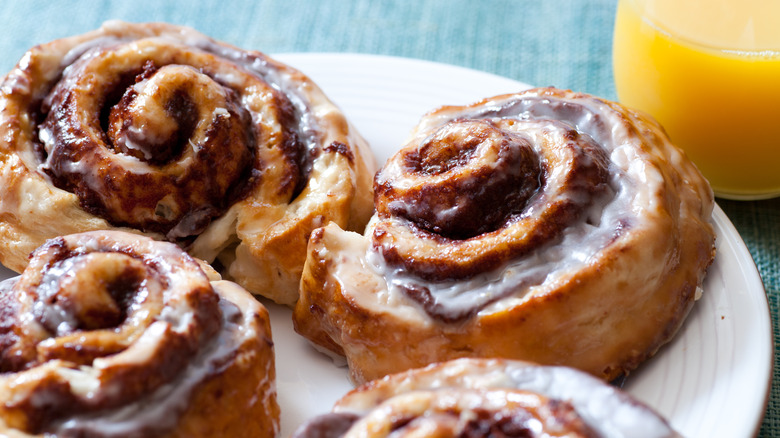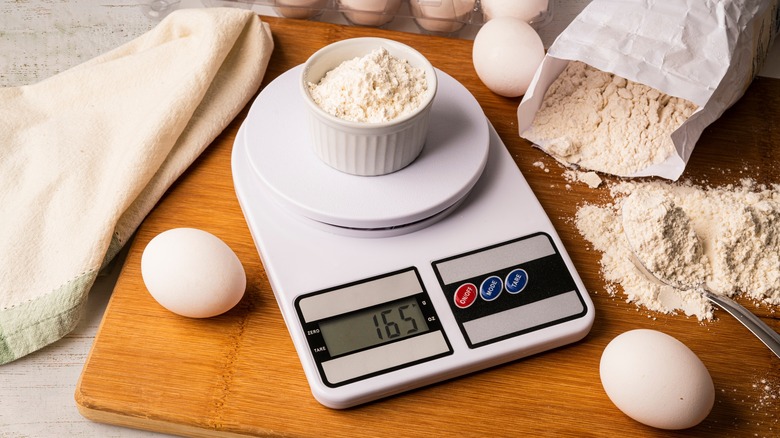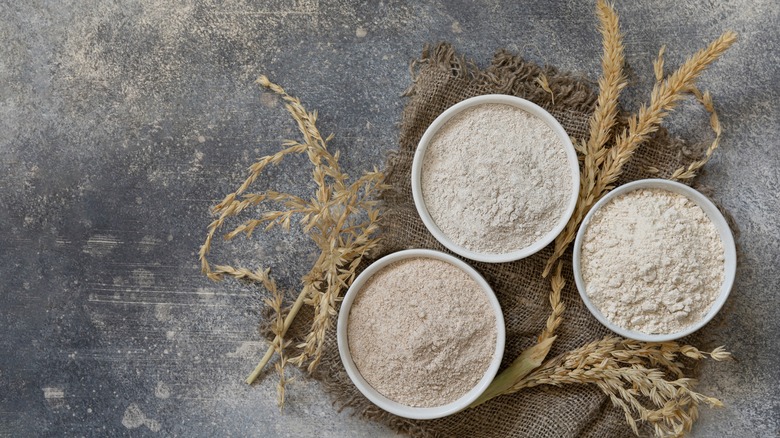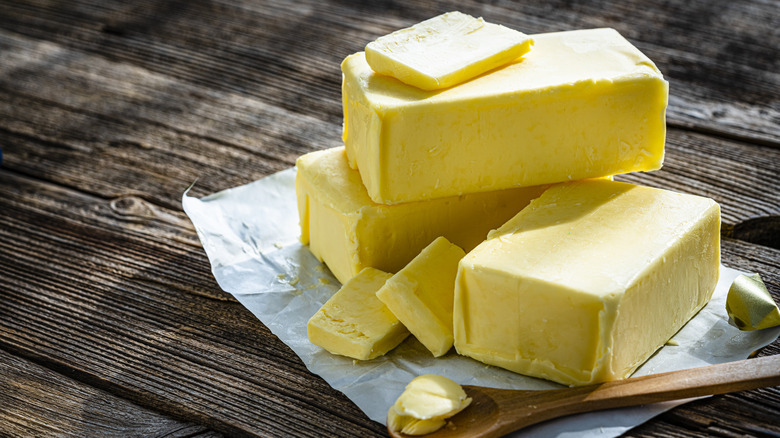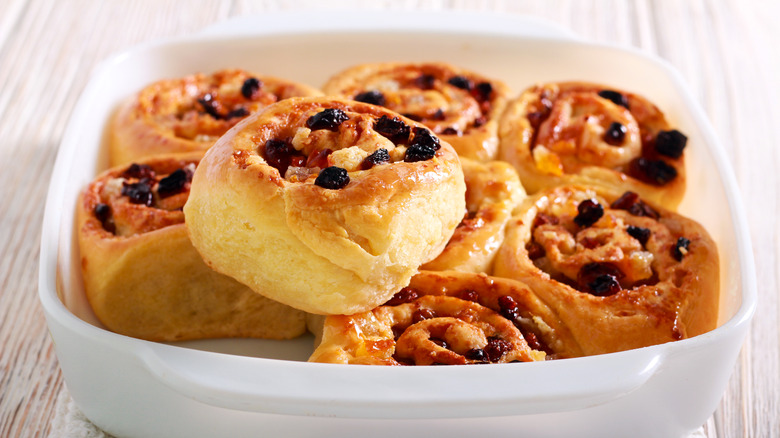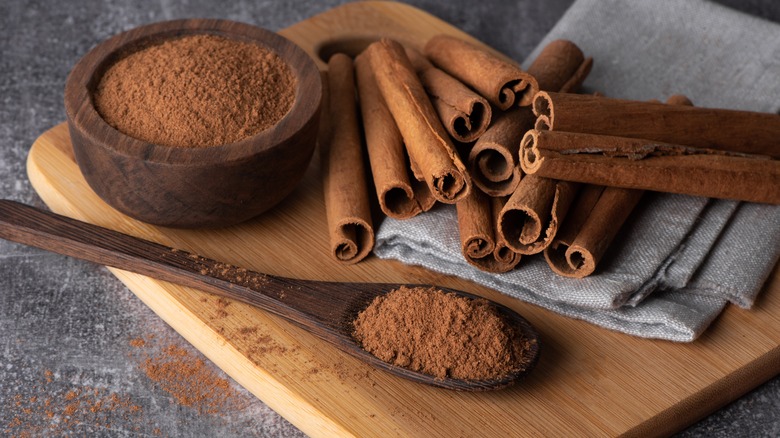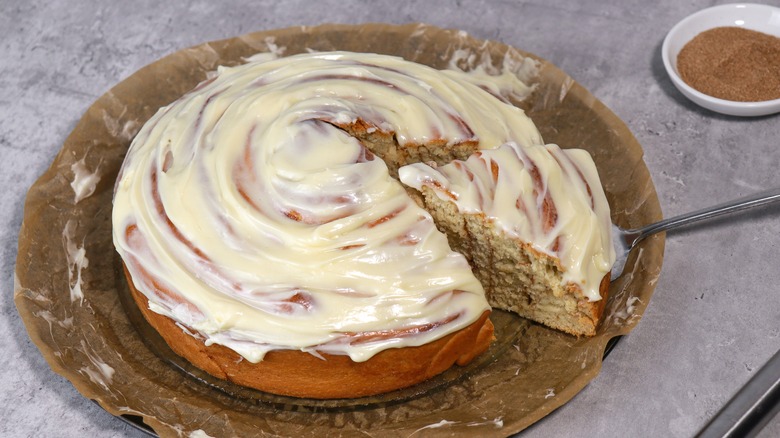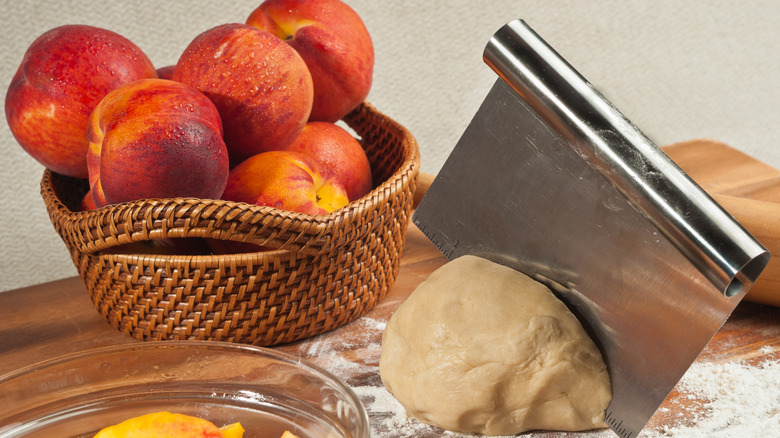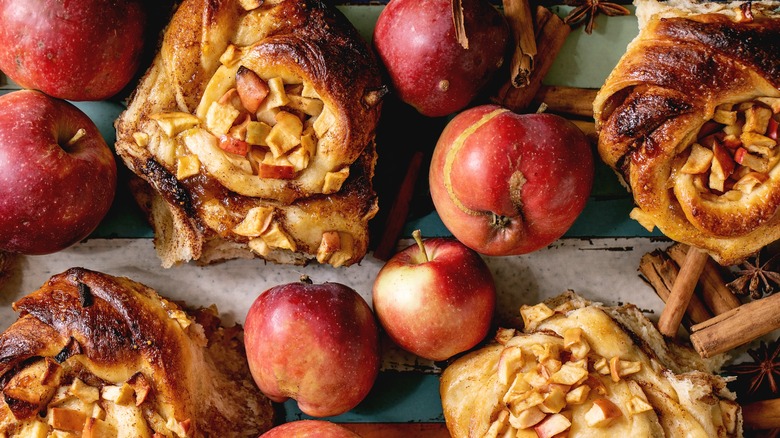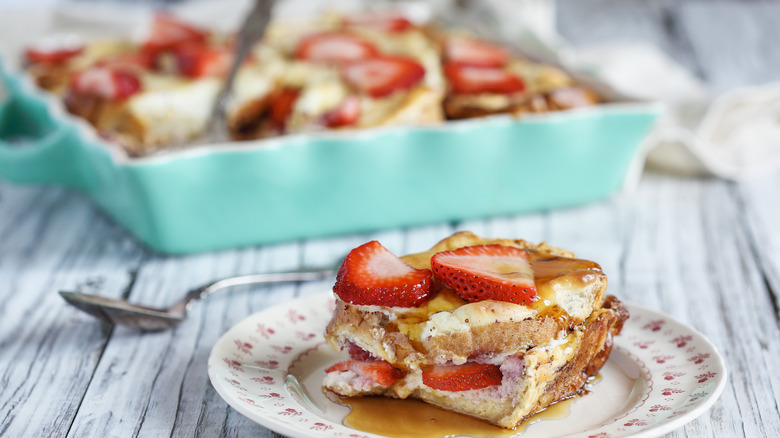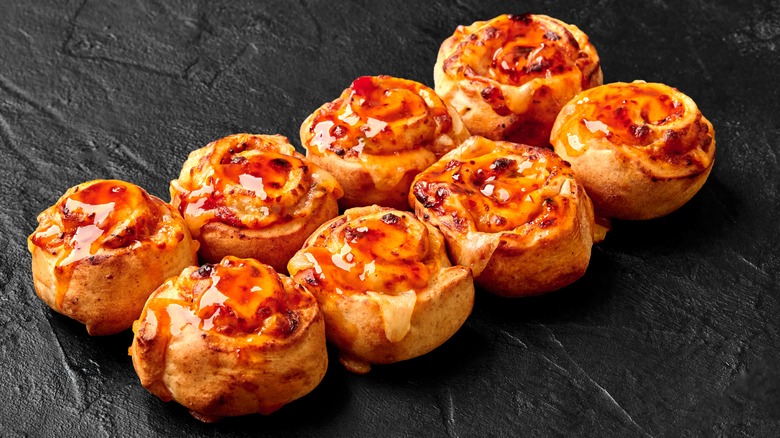Tips For Making Irresistible Cinnamon Rolls From Scratch
We've all been to the mall and been hit with that intoxicating scent of a giant, melty cinnamon roll. Jerilyn Brusseau, creator of the Cinnabon cinnamon recipe, says the perfect roll should be "moist, [and] the texture of the dough would have a kind of pillowy sensation" (via KIRO Newsradio). A tough cinnamon roll is a sad cinnamon roll.
There aren't many pastries that are more delicious than a warm, gooey cinnamon roll bathed in tangy cream cheese frosting — except maybe two! When baked correctly, cinnamon rolls are the best baked goods. The thick layer of cream cheese frosting brings sweetness that is balanced by the woodsy, slightly citrusy taste from the cinnamon filling. All encased in dough, this is why cinnamon rolls are classic and beloved.
While traditional cinnamon rolls are delicious, you can get creative with options to turn these tasty breakfast dishes into something unexpected and flavorful. With some tweaks, your cinnamon rolls can become savory entrées or accompaniments for lunch and dinner. With some tips and tricks, you can make our own decadent rolls at home to rival those mall versions.
Baking is a science
The heart of a good bake is understanding that baking is a science. Some things, including room temperature, affect your bakes but are more difficult to control; other elements, such as your ingredients, are adjustable. Understanding the impact of different flours, butters, or yeasts is key to creating the best bakes.
Before worrying about which ingredients you use, even the best, most expensive butter, salt, or fillings won't matter if you don't have precise measurements. There are moments in making cinnamon rolls that won't matter quite as much, like how much frosting you pour on the top. But, imprecise measurements in the dough can alter the texture or not allow the dough to rise properly.
Most bakers prefer using weight to volume when measuring because it is more precise. If using weight, you will want a scale that has a "tare" option. Tare removes the weight of the container so it only measures the ingredient, not the container with it.
Another important part of baking science is yeast. Yeast is helpful little bacteria that creates air in the dough, which creates both the rise and air pockets. While there are many types of yeast — including instant, fresh, and active — the most important thing is to keep it properly stored between uses. You can freeze yeast between baking, but you will need to allow it to come to room temperature before starting a bake.
Flour power
One of the most important and discussed elements in the baking world is how to best use various flours. When baking, all-purpose flours (AP) are the go-to, but when making bread, bread flour is often recommended. What's the difference, and does it matter? Some bakers say it matters but it's up to you to decide.
The primary difference between the two flours is their protein content. While different brands may have varying protein contents, bread flour always has a higher protein content than AP. Protein in flour creates gluten, so the higher the protein content, the more gluten will be produced. Gluten creates stretch and strength in dough, resulting in an airy texture. In the case of cinnamon rolls, higher gluten content creates a more pillowy feel.
If you're unsure which is best, follow what the recipe calls for. Overall, AP flour will result in a great bake for most recipes, but again, follow the recipe for the best results. When buying AP or bread flour, avoid bleached varieties and flour containing bromide. Bleached flour is chemically processed to age it, but most nutritional benefits of the grains are also removed.
Butter me up
The most commonly called for fat for cinnamon rolls is butter, either salted or unsalted. Between those and others, does the choice of butter make much difference? The main reason to use unsalted butter is when salt needs to be measured precisely or salt is already included in the recipe. Using unsalted butter allows you control over the sodium content in your dish. You also get the benefit of the pure cream flavor.
If you want to further amp up the creaminess in your bakes, try European butter. U.S. butters have to have a minimum of 80% butterfat, whereas European varieties have a minimum of 82% butterfat. That difference in American butter comes from more added water. While European butter does cost a bit more, your dough will be more flavorful. Due to the additional fat content, the dough will have more complexity in flavor.
Whichever butter you choose, make sure to use it at the right temperature. Always read through the recipe first. Some doughs instruct you to use cold butter cut into pieces while others may instruct you to use melted butter for the dough. When making your filling, use softened, not melted, butter. Melted butter can squeeze out of the dough when rolling or bake out of the center.
Filled to the brim
While the dough is important for cinnamon rolls, it's really just a base for flavors. Your favorite dried fruits such as cranberries, cherries, or blueberries all work beautifully as part of your filling. The addition of dried fruits turns your cinnamon rolls into jeweled beauties.
Add a little lemon, orange, or other citrus zest into your dough while mixing to heighten the flavors of both your dough and your added fruit. Instead of the usual filling, add or change it to your favorite fruit jams to add a fresh, fruity flavor profile. Sneak veggies into your dough with some grated carrots, add raisins to your filling, then top with classic, cream-cheese frosting after baking for carrot cake rolls!
Chopped or slivered nuts in both the filling and sprinkled onto your frosting add more texture and nutty flavor. Sprinkle chocolate chips into your filling for an additional flavor bomb, then drizzle chocolate over your frosting as a finishing touch. Another substitute for cinnamon filling is dark chocolate hazelnut spread. Also, try other chocolate spreads like cookie butter or chocolate chips for the ultimate treat. Turn your rolls into sticky caramel rolls by substituting salted caramel spread as your filling, or sprinkle in toffee bits then top with pecans for toffee rolls.
Cinnamon varieties
The sweet, slightly spicy smell of those gooey mall rolls comes from a special type of cinnamon called makara cinnamon . There are other just as tasty and beautiful options! While not all cinnamons are alike, all originate as an inner bark of Cinnamomum trees. The bark curls and turns brown once dried. This is where you get cinnamon sticks, or the bark is ground up and sold as ground cinnamon.
There are actually several varieties of cinnamon. The more common and inexpensive type is cassia. Cassia is grown primarily in Southern and East Asia and has a darker, reddish color. It has a stronger taste compared to Ceylon, which has a sweeter, more delicate taste and aroma. Cassia is harder to find but is chosen by bakers for its sweetness. The third variety, saigon more attainable makara substitute for cinnamon rolls. Saigon cinnamon packs a bold flavor but is sweet like makara and cassia.
One of the boldest cinnamons is the oft-overlooked Vietnamese cinnamon, which is described as the sweetest, richest, and most vibrant variety. It's a must-have staple for your pantry once you've tried it. Because of its stronger flavor, it works well with more savory flavors. Try adding crumbled bacon with Ceylon cinnamon for big flavors!
Size matters
When making cinnamon rolls, size matters. When creating the iconic Cinnabon rolls, Jerilyn Brusseau said the perfect roll has 7.5 wraps. However, in San Antonio, Texas, there was a popular diner that made a cinnamon roll with only three wraps, weighing in at 3.5 pounds. You read that right — 3.5 pounds of cinnamon roll!
Depending on your desired outcome, size is relevant. Because the San Antonio version only had three rolls, it meant that the dough was extremely thick. However, bigger isn't always better because the pastry can be dry and overly doughy. There can be too much dough against the filling, instead of a more balanced ratio. It is recommended to roll the dough between ¼ inch and ¾ inch. The thinner the dough, the chewier the end result. The thicker dough yields a more pillowy dough.
When rolling, each wrap should be snug but not overly tight. Wrapping too tightly will prevent the dough from rising, resulting in compacted rolls. Overly tight wrapping also means that the fillings might squeeze out, or the centers pop out during baking. After the rolls have been shaped, they also need space between each one both during the second rise and baking. The space allows the rolls room to expand.
Tools of the trade
Some of the trickier elements regarding baking cinnamon rolls aren't about the recipe but the tools used. Cutting cinnamon rolls can be a challenge. How can you cut soft dough without squishing the dough? Unflavored dental floss does the trick and is inexpensive!
When handling bread doughs, you don't want to overhandle them or they can become tough. But, dough is sticky and tough to manage until it reaches that nice, smooth texture. How do you navigate a sticky dough until it's manageable? Bench scrapers can be a baker's best friend, either plastic or metal.
Plastic bench scrapers come in either bendable or hard varieties. Both tend to have a rounded edge and a flat side. The rounded edge makes scraping sticky dough from inside a mixing bowl easier while the flat edge helps with the folding process. Slide the scraper under the dough and fold. The scraper scoops the dough while adding in flour, all while keeping your hands clean. Once your dough is smooth and pliable, the scrapers make cleaning leftover sticky bits or excess flour a cinch!
Baking strips are another handy tool. Wrapping them around the baking dish helps maintain the temperature of your pan while baking. The strips keep the bake consistent, which can be tricky for cinnamon rolls. Sometimes, the outsides tend to get dry while leaving a doughy, uncooked center. Baking strips can help alleviate this.
Top it all off
If you've made homemade or pop-can cinnamon rolls, sometimes the dough tastes dry. The mall cinnamon rolls combat dry dough by pouring warm heavy cream over the cinnamon buns before baking. The cream absorbs into the dough, making it moist and delicious. To intensify the cinnamon flavors of your filling, add a little cinnamon to the cream frosting. The added cinnamon in the frosting not only intensifies the filling flavors but helps moderate the sometimes overly sticky sweetness of the frosting. The flavors are more harmonious and complex, resulting in happy taste buds. Before baking, add pie filling over the rolls to add more punch. You can add a savory salt bomb and sprinkle in crumbled bacon bits either before baking or on top of the frosting.
While it's inedible, another "topping" is tin foil. While the aforementioned baking strips help regulate temperatures, covering the rolls with foil aids in preventing burning. The foil allows the rolls to cook all the way through while protecting the top of your bake. Just remember to remove the foil a few minutes before the rolls finish cooking to allow your rolls to brown.
It's all in the technique
Maybe you're not in the mood to have big ol' cinnamon rolls but still want the gooey flavors? Switch up the techniques and try something new! Use a waffle iron to bake the dough instead of putting them in the oven for cinnamon roll waffles! (You can also simplify baking and use the rolls from a can — no judgment). When scooping the rolls into the waffle iron, you will want to press the dough a bit with your palms. A thicker dough means longer bake times.
It seems like everyone is using an air fryer, so why not try it for cinnamon rolls? Roll the dough into balls, and set in the bottom of a paper towel–lined air fryer. Bake at 325 degrees for a few minutes until golden brown. While still warm, toss your golden nuggets in a mixture of sugar and cinnamon. Dip with your favorite frosting and you've got an amazing treat!
For brunch or holiday breakfast, take your French toast up a notch and use your recipe to make French toast casserole. Instead of rolling the dough into rolls, cut it up into pieces, top with cream and cinnamon for a flavorful casserole, or really wow everyone with cinnamon roll pie with apples.
Not just for breakfast
Cinnamon rolls don't have to only be eaten for brunch or breakfast. If you're unfamiliar with chili with cinnamon rolls, it's a classic Midwestern combination. Cinnamon rolls and chicken noodle soup make an amazing meal. Replacing the cinnamon/sugar filling with savory fillings like bacon and chives with cheese, ham and cheese, or spinach artichoke dip with feta makes a new, savory dish. Use your dough and roll in pizza toppings like pepperoni and sausage sprinkled with parmesan cheese over your favorite pizza sauce to make a delicious dinner. Pour melted herb butter on top instead of frosting to heighten the flavors of your savory fillings.
Instead of melted herb butter, try classic sauces like béarnaise drizzled on top. Combine bacon with a mixture of thyme, tarragon, onions, or scallions with butter for another savory filling option. Change your filling from cinnamon and sugar to pesto with strips of rotisserie or grilled chicken for another twist that combines classic dishes. Pulled pork with BBQ sauce as your filling topped with grated cheddar is incredible. Go to the next level and use your cinnamon roll dough to make rolled muffulettas.

